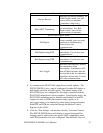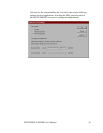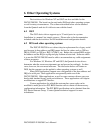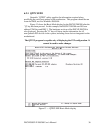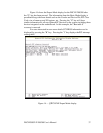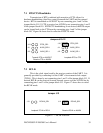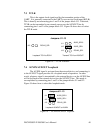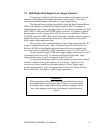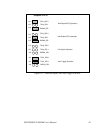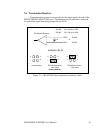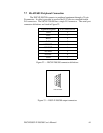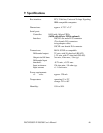
7.5 Half-Duplex/Full-Duplex/Auto-Toggle Selection
Using jumper blocks J14 thru J16, the transmitters and receivers of each
channel can be enabled and disabled by modem control signals. This allows
operation in both half-duplex, full-duplex or Auto-Toggle modes.
The transmit drivers can be controlled by either the Data Terminal Ready
(DTR) or the Request to Send (RTS) output from the UART. If a jumper is
applied between pins 1 and 2 of jumper block J14, the drivers are enabled for TxD
and AUXOUT when the UART's DTR signal is asserted. If a jumper is applied
between pins 1 and 2 of jumper block J15, the drivers are enabled for TxD and
AUXOUT when the UART's RTS signal is asserted. If neither of these jumpers is
applied, the drivers remain enabled at all times. When disabled, the transmit
drivers enter a high-impedance state.
The receivers can be controlled by the inverse of the transmit enable. If a
jumper is applied between pins 1 and 2 of jumper block J16, the receivers for
RxD and AUXIN will be disabled when the transmit drivers are enabled and
vice-versa (based on the DTR or RTS connections on pins 1-2 of J14 and J15.
To operate in half-duplex DTR mode, apply jumpers between pins 1 and 2
of jumper blocks J14 and J16. To operate in half-duplex RTS mode, apply
jumpers between pins 1 and 2 .of jumper blocks J15 and J16
To operate in full-duplex mode, leave the jumpers in their factory default
locations, installed in the spare locations of J14-16 only. The drivers and
receivers are always enabled in full-duplex mode. For Auto-Toggle, apply
jumpers between pins 1 and 2 of jumper blocks J14 and J15. Figure 20 shows
how to select half-, full-duplex or Auto-Toggle operation.
WARNING:
When operating in half-duplex mode, the transmitter drivers must
be disabled before receiving any data. Failure to do so may result
in multiple active output drivers being connected together, which
may cause damage to the board, the computer, and the external
device.
DSCLP/SSCLP-200/300 User's Manual 41



